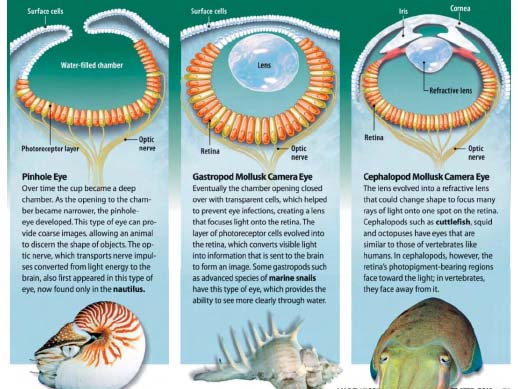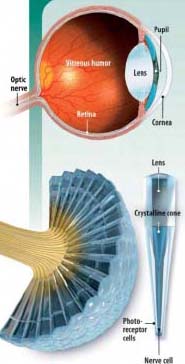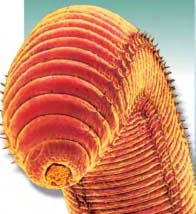╧юёхїхэшщ:  ▌┬╬╦▐╓╚▀ ├╦└╟
▌┬╬╦▐╓╚▀ ├╦└╟
|
|
The Science of Eye
SCIENCE ILLUSTRATED MARCH/APRIL 2009, P 28-32
|
|
|
Fishermen on a trawlrr from New Zealand hauled in an unexpected catch off the coast of Antarctica in February 2007: a colossal squid weighing more than 1,000 pounds. Astounded by this rare find lew colossal squid, no: lobe confused with smaller giant squid, have ever been capturedЧthe fishermen scooped up the squid in a net, brought it onboard, and froze it in a block of ice.
Their chance discovery proved to be the best-preserved specimen ever brought back to port. It was taken to the Museum of New Zealand Te Papa Tongarewa, the national museum in Wellington, for study. Even before the squid was thawed, scientists could see the world's largest eyes staring up at them through the ice. Measuring nearly 11 inches in diameter, each eye was about the size of a soccer ball.
Unreal as that may sound, it makes perfect sense. The colossal squid lives some 3.000 feet below the ocean's surface, where it is too dark for most animals to see anything. But the squid's eyes are well suited to its environment. Its pupils are 3.5 inches in diameter, allowing it to collect even the faintest light and thus spot prey, predators (mainly sperm whales) and other squids in the darkness.
Other species have developed different types of eyes depending on where and how they live. What's clear from all these variations, though, is that the ability to see has been a key factoT in determining which species thrive and which ones perish. For hundreds of millions of years, animals have been locked in a fierce competition to develop belter vision.
The Origin of Eyes
The first light-sensil ive cells appeared in the animal kingdom more than halt a billion years ago, say Todd Oakley and David Plachetzki of the University of California at Santa Barbara. In 2007 the biologists searched I he genomes of hydras and sponges, two simple ancient sea creatures, looking for a gene that codes for a light-sensitive protein called opsin Ч the foundation of vision. They found the gene in hydras but not in the more primitive sponges, which indicated that the gene arose by mutation before hydras emerged, more than 600 million years ago.
|
an electrical signal. The earliest "eyes" were small patches of photoreceptors on the surface of multicellcd animals. Today some mollusks still have such patches, known as eyespots. They don't resemble eyes as we know them but look more like clusters of sensing cells, such as taste buds on the tongue. Despite their primitive construction, eyespots can register information about light conditions and thus allow animals to tell if it is day or night and to either seek sunlight or avoid it.
The Evolution of Sight
For tens of millions of years, vision was limited to this basic ability to tell dark from light. This changed more than 530 million years ago during the so-called Cambrian explosion, when most animals' ancestors first appeared. Scientists hypothesize that intense competition

| |
|
Mammalian vs. Insect Vision
The eyes of mammals and insects are vastly different, but both are well suited to their tasks. Most adult insects have compound eyes in which each facet, or ommatidium, functions as an independent receptor, detecting light from a small area within the field of view. Each ommatidium forms one picture element in a pattern of dark and light dots and is compiled with information from the other ommatidia to create an image.The more ommatidia an animal has, the finer the pattern of dots and the better the image quality. Some insects have an almost 360-degree view of the world because their eyes wrap around their heads, and some can detect far
slighter movements than people can.
Mammalian eyes, however, are better at focusing on specific areas of the visual field because the curvature of the lens can be adjusted by expanding or contracting muscle fibers that hold it in place. Insects get only a partial image of distant objects because their lenses have a fixed focal length.
Some animal eyes can differentiate colors, see in dim light, or detect movement. For example, dragonflies have eyes with up to 30,000 facets each, pointing in all directions. Even while traveling at top speed (about 35 mph), a dragonfly can spot a moving mosquito with just one of those facets.
 Human Eye
Human Eye
The mammalian eye uses a cornea, pupil, lens and vitreous humor (liquid that holds the lens in place) to guide light to the retina at the back of the chamber. In the human eye, light enters through the pupil and is focused on the retina by a flexible refractive lens. The retina contains three types of light-sensitive cells: rods, cones and retinal ganglion cells. Rods and cones detect brightness and color, respectively. Ganglion cells adjust the body's cir-cadian rhythms and pupil size, collect chemical impulses, and process the information, sending it on to the brain via the optic nerve.
Insect Eye
Also called a compound eye, the insect eye has multiple facets, each with a fixed lens and crystalline cone that focuses the light on photoreceptor cells that relay information to the brain. The number of facets varies from just a few in some species to tens of thousands per eye. Each facet is responsible for only a small area of the field of vision.
|
between all these species favored the evolution of eyes that could provide actual images of their surroundings. As eyes developed further, predators were able to see their prey, prey could detect predators, and animals of the same species began to communicate with each other in new ways.
First, eyespots evolved into cup-shaped structures in which light struck different photopigment cells at different angles. As the cup grew deeper over time, the animal was better able to determine the direction that light was coming fromЧwhich provided more information about its surroundings. Today some flatworms and snails use cup-shaped eyes to orient themselves to light and to detect the shadows of predators.
Eventually the eye became a deep chamber with a small opening that focused light onto one point, rather than gathering many beams, resulting in a less blurry image. This pinhole eye, found today only in the sea-dwelling mollusk, the nautilus, is an evolutionary dead end. It allows animals to detect objects, but the image is still grainy, with few details. Clear focusing requires a lens, something the nautilus still lacks after 500 million years but which has evolved in other animals. The lens focuses vision by bending light rays so that they converge on a small patch of retinal tissue at the back of the chamber. Later the single-chambered eye evolved into an even more complex organ containing a pupil, an iris and other structures that together create detailed images for the brain to interpret.
A Colorful World
Photoreceptors are divided into two types: rhabdomeric, which are found in invertebrates such as the colossal squid, insects, worms and mollusks; and ciliary, characteristic in humans and other vertebrates. Although they differ in structure, both have countless folds to increase the surface area available for gathering light.
When light photons strike photo-pigments in either type of photoreceptor cell, they activate the opsin protein.
|
The Best Color Vision in Nature
Mantis shrimp seethe most colors of any animal in the world. Some species, such as the peacock mantis of the Indo-Pacific Ocean, have hyperspectral super-vision, thanks to 15 different photoreceptor types in their eyes. Twelve of them are used for detecting colors that are visible to humans, while the remaining three detect polarities, or directions, of light. In addition, oil droplets in their eyes function as color filters that further refine the shrimp's vision by narrowing the spectral sensitivity of individual photoreceptors.This means that different photoreceptors will respond not only to specific colors but also to various wavelengths of light within those colors.
Human eyes cannot detect the polarity of light, b ut who can may use it to find their way in low-light conr. lit The ability to detect the polarity of light also helps to er contrast on cloudy days or against strongly reflecting b grounds.This ability may help the mantis shrimp to pie parent prey animals and predatory fish with shimmeiin Mantis shrimp may also use this light to communicate \ another with movement, since many of them have p;itt their body that are apparent only in polarized light. |
stimulating biochemical reactions that create an electrical signal. In animals that have well-developed camera eyes but no brain, such as the Gadonema jellyfish, these electrical impulses are fed directly into a ring-shaped nervous system that triggers reflexive movements in muscles. In more complex animals, rhe electrical signals go to the brain's visual-processing center, which in turn sends out electrical messages that help direct the movement of muscles.
Even though scientists have a solid understanding of how photoreceptors work to create a coherent picture of an animal's surroundings, they still don't comprehensively understand how thinking and intelligence interprete the information, nor do they know exactly how animals detect types of light tiiat human eyes cannot register. For example, some spiders and bees can detect the polarity, or direction, of light. The eyes of these insects have specialized photoreceptor cells that react only to light coming from a particular direction. Using these cells, the animals can oiien: themselves in relation to the sun even on overcast days.
As for color perception, human retinas contain three binds of photoreceptor cells, with photopigments that are sensitive to orange, green or blue light. But honeybees, ants and other insects, lizards, turtles, many rodents, birds and fish experience a more colorful world than we do, thanks to a fourth type of photoreceptor that enables them to see in ultraviolet wavelengths.
Humans are oblivious to information that many birds and insects can use. When we look at a blue tit, for example, we see a bird with a yellow breast, green back and blue cap. But when one of these birds spots another, it may also see feathers in the blue cap that reflect UV light. This reflection reveals whether the bird is a male or a female, since males have more brilliant caps. Females then choose the brightest of the males as mates. And this species is not alone. A 2007 survey of more than 1,000 bird species conducted by the Leibniz Institute for Terrestrial Biodiversity in Bonn. Germany, revealed that more than half of them have feathers that reflect UV light.
In the end, what any animal sees is nothing more than a perception that arises in the brain when certain sensory neurons are activated. It is true that objects absorb certain wavelengths of light and reflect the rest. It's also true that the colors we perceive are related to the wavelengths of light an object reflects. But the colors we see depend on what our photoreceptors can detect and how our brain processes that information. Thus, although we see a blue tit, we don't see one of its most important featuresЧthe color of the feathers that reveals its gender.
Most bird eyes have four photopigments and thus four-color vision, but most mammals have just two types, those that detect blue and yellow. Mammalian vision most likely developed when dinosaurs dominated the land, and mammals were small animals that crept out only at night, hi nocturnal darkness, the early mammals had more need for light-sensitive cells in their retinas than for color vision. Certain mammals lost two of their original four photopigmenls and developed a far less nuanced color vision than birds. Owl monkeys and marine mammals, like whales, lost one more photopigment and thus see monochromatically.
Once dinosaurs disappeared 65 million years ago, scientists theorize, mammals literally emerged from the darkness and became active iin the daytime, climbed into the trees, and made fruit a staple of their diet. But with only two photopigments, the ancestors of modern primates could barely discriminate between colors in the green, yellow and red spectrum, so they would have had trouble finding food and distinguishing ripe from unripe fruit. Then about 40 million years ago, one of their two photopiigments duplicated and mutated into a third. The extra pigment was advantageous in a colorful daytime world, and it spread throughout the primate ancestors of humans, apes and old-world monkeys, such as baboons and macaques. That's why these species have three photopigments instead of two like the majority of their mammalian peers.
The Necessities of Night Vision
Eyes have since continued to evolve to suit the environments in which they are found. For most animals, colors disappear in the darkness of night. Some moths and other animails can distinguish flowers at night by their color, but many nocturnal animals rely on black-and-white vision to optimize inputs from weak light sources. In addition to having more light-sensitive and fewer color-sensitive cells; in the retina, animals that see well in the dark, like owls, also tend to have larger eyes, lenses and pupils, which allow them to gather more light. And a reflective layer called the tape turn llucidum bounces light that has already passed through the retina back to it, giving photoreceptors there a second chance to detect light.
The colossal squid's enormous eyes give it a clear image of the extreme depths that most animals would simply perceive as pilch-black, liven dv.ring the day, the deepest waters of the oceans arc almost completely dark, because the top layers of water quickly reflect sunlight. The darkness there is broken o:ilv bv I lashes oi'lighl emined by lisb. squid, crustaceans, jellyfish and other marine animals. These flashes are typically blue, since blue light travels farther in water than other colors. Therefore, the eyes of most deep-sea creatures can perceive blue light but are almost always blind to red light, which is absorbed by the darkness.
A few animals, such as the deep-sea dragonfish found in the tropics, are exceptions. These fish emit beams of red light from luminescent organs under their eyes, so they can communicate without being detected by predators. The light also functions like the red laser from a sniper's rifle, helping the fish to pinpoint and capture its prey.
Big Research
Much still remains to be learned about animal vision, and the enormous eyes of the colossal squid specimen found in Antarctica pose an exciting opportunity. Researchers know from studying the brains of other species of squid-including the slightly smaller giant squid, which also has huge eyesЧthat most of the squid brain is devoted to proa ssing visual signals. But scientists do not yet know whether the colossal squid uses its visual prowess to form high-resolution images, or instead sacrifices resolution and maximizes light-gathering by combining inputs from multiple cells in the eye before sending visual information on to the brain.
Today the colossal squid is on exhibit at the Museum of New Zealand Te Papa Tongarewa. Before the show was mounted last December, scientists from Lund University in Sweden examined one of the animal's eyeballs. Their fmdings, coupled with those from the dissected eye of a smaller colossal squid captured in 2003, are due this year. By uncovering how the squid eye works, the researchers believe that we'll gain a better understanding of visual systems in other species, including our own.
|
Chameleons Hunt with Telescopic Sights
A chameleon's eye has a unique concave lens that functions like the telephoto lens of a camera, creating a much larger image on the retina than other animals' eyes of the same size can. The lens also increases the area and resolution in which the eye can see sharply at the center of the image.
Vertebrates tend to increase corneal power and decrease lens power to achieve the clearest vision; however, the chameleon has reversed the power of its lens to allow for precise long-distance vision Ч an ability unique to the species.
Chameleons measure dist ince by the effort it takes to focus il s eyes. Scientists believe that chameleons'eyes bring prey into sharp focus, and by the amount of focusing the lens has to do, the lizard determines how far it must extend its tongue to catch the prey.
Chameleons focus faster and over longer distances than other terres-trial vertebrates. Because they can also move each eye independently, nothing escapes their sight. |
╨б╨░╨╣╤В ╤Б╨╛╨╖╨┤╨░╨╜ ╨▓ ╤Б╨╕╤Б╤В╨╡╨╝╨╡
uCoz

 Human Eye
The mammalian eye uses a cornea, pupil, lens and vitreous humor (liquid that holds the lens in place) to guide light to the retina at the back of the chamber. In the human eye, light enters through the pupil and is focused on the retina by a flexible refractive lens. The retina contains three types of light-sensitive cells: rods, cones and retinal ganglion cells. Rods and cones detect brightness and color, respectively. Ganglion cells adjust the body's cir-cadian rhythms and pupil size, collect chemical impulses, and process the information, sending it on to the brain via the optic nerve.
Human Eye
The mammalian eye uses a cornea, pupil, lens and vitreous humor (liquid that holds the lens in place) to guide light to the retina at the back of the chamber. In the human eye, light enters through the pupil and is focused on the retina by a flexible refractive lens. The retina contains three types of light-sensitive cells: rods, cones and retinal ganglion cells. Rods and cones detect brightness and color, respectively. Ganglion cells adjust the body's cir-cadian rhythms and pupil size, collect chemical impulses, and process the information, sending it on to the brain via the optic nerve.